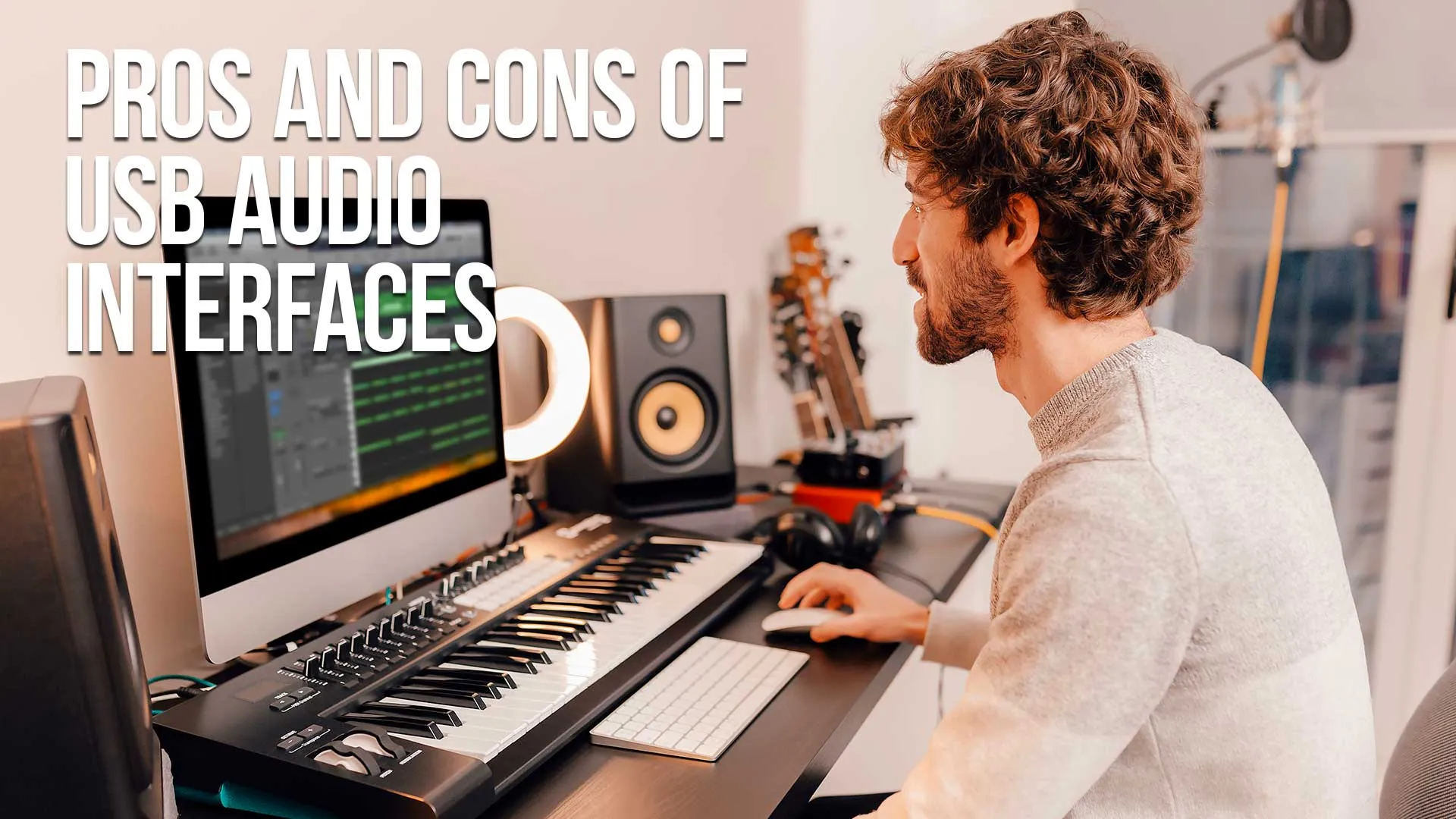When it comes to recording music or any other audio, one of the most important factors to consider is the interface that you use.
A USB audio interface is an essential piece of equipment for any musician, producer, or audio engineer, and it's important to understand the pros and cons of using one.

What is a USB Audio Interface?
A USB audio interface is a device that connects to a computer and allows you to record and play back audio.
The interface typically has inputs for microphones, instruments, and other audio sources, and outputs for speakers or headphones.
The best USB audio interfaces typically have a built-in preamp, which amplifies the signal from a microphone or instrument, making it strong enough to be recorded by the computer.

What are the Pros and Cons of Using a USB Audio Interface?
Pros of Using a USB Audio Interface
One of the biggest advantages of using a USB audio interface is the ease of use.
With a USB connection, you can simply plug in the interface and start recording.
This makes it much easier to get started with recording than other types of interfaces, which may require more setup and configuration.
Another benefit of using a USB audio interface is the improved sound quality.
Because the preamp is built into the interface, you don't have to worry about using a separate preamp, which can be a source of noise and distortion.
Additionally, USB audio interfaces often have higher-quality converters than your computer's built-in sound card, which results in better sound quality for your recordings.
Another advantage of USB audio interfaces is the flexibility they offer.
With the ability to connect multiple inputs, you can record multiple sources at once, making it easier to produce multi-track recordings.
Additionally, many USB audio interfaces offer additional features, such as effects processing, which can add depth and character to your recordings.

Cons of Using a USB Audio Interface
One of the biggest drawbacks of using a USB audio interface is the cost.
While there are some low-priced options available, the high-quality interfaces that professional musicians and producers use can be quite expensive.
Additionally, the cost of a USB audio interface can quickly add up when you consider the additional equipment, such as microphones and speakers, that you'll need to get started.
Another potential drawback of using a USB audio interface is compatibility.
Not all computers are compatible with all interfaces, so it's important to make sure that the interface you choose is compatible with your computer.
Additionally, some interfaces may not be compatible with older computers, so it's important to check before making a purchase.
Finally, some users may find that USB audio interfaces are not as portable as other types of interfaces.
While they are certainly more portable than older analog interfaces, they still require a computer to function, which can make them less ideal for musicians who need to record on the go.

Technical Specifications to Look for in a USB Audio Interface
Bit Depth and Sample Rate: These determine the audio quality. Look for at least 24-bit depth and 48kHz sample rate.
Input/Output (I/O) Count: Match this with your needs. More I/Os offer greater flexibility.
Preamp Quality: High-quality preamps ensure better sound from microphones.
Latency: Lower latency is critical for real-time monitoring.
Connectivity: Ensure compatibility with your computer’s ports, like USB-C or Thunderbolt.
Durability and Build Quality: A sturdy build ensures longevity.
Software Compatibility: Check if it works seamlessly with your recording software.
Additional Features: Consider extras like built-in effects or MIDI support.
Conclusion
In conclusion, USB audio interfaces are a great choice for musicians, producers, and audio engineers looking for a simple and easy-to-use solution for recording and playing back audio.
With improved sound quality and flexibility, USB audio interfaces offer many benefits over other types of interfaces.
However, it's important to consider the cost and compatibility issues before making a purchase.
Pros and Cons of USB Audio Interfaces - FAQ
What is a USB Audio Interface?
A USB audio interface is a device that connects musical instruments and microphones to a computer, allowing them to be recorded or used as a source of sound.
What are the benefits of using a USB Audio Interface?
There are many benefits to using a USB audio interface, including improved sound quality, easier setup, and greater versatility. A USB audio interface can help you achieve better recordings and live performances, as well as provide greater control over your sound.
What are the drawbacks of using a USB Audio Interface?
While there are many benefits to using a USB audio interface, there are also some drawbacks. One of the main drawbacks is that some USB audio interfaces can be expensive, which may not be feasible for all musicians or audio professionals. Additionally, some USB audio interfaces can be complicated to use, requiring a significant amount of knowledge and expertise.
What should I consider when choosing a USB Audio Interface?
When choosing a USB audio interface, there are a few things to consider, such as compatibility with your computer and audio software, number of inputs and outputs, and cost. It's important to choose a USB audio interface that fits your specific needs and budget.
What is the difference between USB 2.0 and USB 3.0 audio interfaces?
The main difference between USB 2.0 and USB 3.0 audio interfaces is the speed at which data is transferred between the interface and the computer. USB 3.0 is faster than USB 2.0 and provides lower latency, which is important for real-time audio applications.
How many inputs and outputs do I need in a USB Audio Interface?
The number of inputs and outputs you need in a USB audio interface depends on your specific needs. If you're using a single microphone or instrument, you'll likely only need a single input. However, if you're recording a full band or using multiple sources of sound, you may need more inputs. The same applies to outputs - the number you need will depend on your specific setup and requirements.
Can I use a USB Audio Interface with my existing audio equipment?
Yes, you can use a USB audio interface with your existing audio equipment. Most USB audio interfaces have inputs and outputs that allow them to be used with a variety of different equipment, such as microphones, instruments, and speakers.
Is a USB Audio Interface necessary for recording music?
While a USB audio interface is not necessary for recording music, it can greatly improve the quality and ease of your recordings. A USB audio interface can provide improved sound quality, better control over your sound, and more versatility, making it a valuable addition to any recording setup.
Can I use a USB Audio Interface for live performances?
Yes, you can use a USB audio interface for live performances. Many USB audio interfaces are designed specifically for live use, and can provide improved sound quality, lower latency, and greater control over your sound, making them ideal for live performances.
What is the best USB Audio Interface for my needs?
The best USB audio interface for your needs depends on a variety of factors, such as your budget, your specific setup and requirements, and your personal preferences. It's important to do your research and choose a USB audio interface that fits your specific needs.

About the Author
Joseph Nilo has been working professionally in all aspects of audio and video production for over twenty years. His day-to-day work finds him working as a video editor, 2D and 3D motion graphics designer, voiceover artist and audio engineer, and colorist for corporate projects and feature films.
Pro Audio Production Related Posts
Top 9 Condenser Microphones for Recording Voice and Vocals
Best Microphones For YouTube Videos 2022
Best Gaming Headsets with Good Microphones
The Ultimate Guide to the Premiere Pro Essential Sound Panel
Best External Wired and Wireless Mics for iPhone
The Pros and Cons of Podcast Mixers
7 Best Audio Mixers for Podcasting in 2023
The 8 Best USB Audio Interfaces For Podcasters and Musicians 2023
- What Is A USB Audio Interface?
- What Are The Pros And Cons Of Using A USB Audio Interface?
- Pros Of Using A USB Audio Interface
- Cons Of Using A USB Audio Interface
- Technical Specifications To Look For In A USB Audio Interface
- Conclusion
Pro Audio Production Related Posts
Top 9 Condenser Microphones for Recording Voice and Vocals
Best Microphones For YouTube Videos 2022
Best Gaming Headsets with Good Microphones
The Ultimate Guide to the Premiere Pro Essential Sound Panel
Best External Wired and Wireless Mics for iPhone
The Pros and Cons of Podcast Mixers
7 Best Audio Mixers for Podcasting in 2023
The 8 Best USB Audio Interfaces For Podcasters and Musicians 2023
